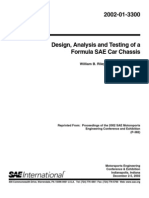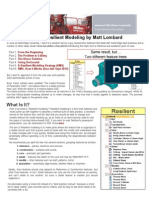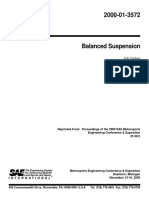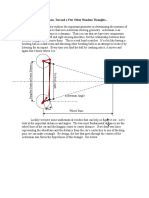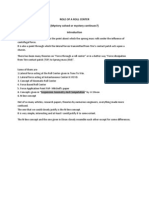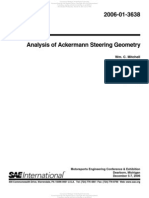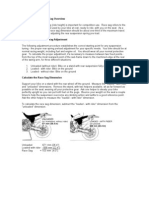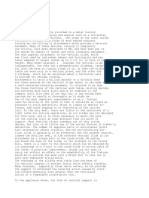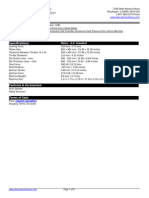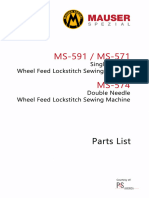2000 01 3554
2000 01 3554
Uploaded by
Rohan DateCopyright:
Available Formats
2000 01 3554
2000 01 3554
Uploaded by
Rohan DateOriginal Title
Copyright
Available Formats
Share this document
Did you find this document useful?
Is this content inappropriate?
Copyright:
Available Formats
2000 01 3554
2000 01 3554
Uploaded by
Rohan DateCopyright:
Available Formats
Downloaded from SAE International by SRM Univ, Friday, April 25, 2014 05:05:05 AM
SAE TECHNICAL
PAPER SERIES
2000-01-3554
The Effect of Chassis Stiffness on Race
Car Handling Balance
Andrew Deakin, David Crolla, Juan Pablo Ramirez and Ray Hanley
School of Mech. Eng., The University of Leeds
Reprinted From: Proceedings of the 2000 SAE Motorsports
Engineering Conference & Exposition
(P-361)
Motorsports Engineering Conference & Exposition
Dearborn, Michigan
November 13-16, 2000
400 Commonwealth Drive, Warrendale, PA 15096-0001 U.S.A.
Tel: (724) 776-4841 Fax: (724) 776-5760
Downloaded from SAE International by SRM Univ, Friday, April 25, 2014 05:05:05 AM
The appearance of this ISSN code at the bottom of this page indicates SAEs consent that copies of the
paper may be made for personal or internal use of specific clients. This consent is given on the condition,
however, that the copier pay a $7.00 per article copy fee through the Copyright Clearance Center, Inc.
Operations Center, 222 Rosewood Drive, Danvers, MA 01923 for copying beyond that permitted by Sections 107 or 108 of the U.S. Copyright Law. This consent does not extend to other kinds of copying such as
copying for general distribution, for advertising or promotional purposes, for creating new collective works,
or for resale.
SAE routinely stocks printed papers for a period of three years following date of publication. Direct your
orders to SAE Customer Sales and Satisfaction Department.
Quantity reprint rates can be obtained from the Customer Sales and Satisfaction Department.
To request permission to reprint a technical paper or permission to use copyrighted SAE publications in
other works, contact the SAE Publications Group.
All SAE papers, standards, and selected
books are abstracted and indexed in the
Global Mobility Database
No part of this publication may be reproduced in any form, in an electronic retrieval system or otherwise, without the prior written
permission of the publisher.
ISSN 0148-7191
Copyright 2000 Society of Automotive Engineers, Inc.
Positions and opinions advanced in this paper are those of the author(s) and not necessarily those of SAE. The author is solely
responsible for the content of the paper. A process is available by which discussions will be printed with the paper if it is published in
SAE Transactions. For permission to publish this paper in full or in part, contact the SAE Publications Group.
Persons wishing to submit papers to be considered for presentation or publication through SAE should send the manuscript or a 300
word abstract of a proposed manuscript to: Secretary, Engineering Meetings Board, SAE.
Printed in USA
Downloaded from SAE International by SRM Univ, Friday, April 25, 2014 05:05:05 AM
2000-01-3554
The Effect of Chassis Stiffness on Race
Car Handling Balance
Andrew Deakin, David Crolla, Juan Pablo Ramirez and Ray Hanley
School of Mech. Eng., The University of Leeds
Copyright 2000 Society of Automotive Engineers, Inc.
It is often quoted that to be able to make a race car
handle properly by tuning the handling balance, the
chassis should have a torsional stiffness of X times the
suspension stiffness or X times the difference between
front and rear suspension stiffness [1].
This paper looks at the fundamental issues surrounding
chassis stiffness. It discusses why a chassis should be
stiff, what increasing the chassis stiffness does to the
race engineers ability to change the handling balance of
the car and how much chassis stiffness is required. All
the arguments are backed up with a detailed quasi static
analysis of the problem.
Furthermore, a dynamic analysis of the vehicles
handling using ADAMS Car and ADAMS Flex is
performed to verify the effect of chassis stiffness on a
race cars handling balance through the simulation of
steady state handling manoeuvres.
INTRODUCTION
It is well known that to make a race car handle correctly,
it must be possible to tune the handling balance. Tuning
the handling balance means adjusting the level of grip
available from either the front or the rear of the vehicle.
When both the front and rear axles can produce a force
to give the same lateral acceleration, the chassis can be
said to be balanced.
Figure 1 illustrates the non-linear behaviour of a typical
tyre used with Formula SAE racing cars. Figure 2 shows
the Leeds University Formula SAE car. It can clearly be
seen that if a pair of tyres on an axle had the same
vertical load, then they could both produce the same
maximum lateral force. If for example, the vehicle was
cornering, then the lateral acceleration would cause a
load transfer, equation 1. This lateral acceleration would
increase the vertical load on the outside tyre and
decrease the vertical load on the inside tyre by the same
quantity. The result of this load transfer is that the two
tyres combined can produce less lateral force.
LT =
ma Latacc hCG
t
(1)
where LT is the lateral load transfer for an axle, LATacc is
the lateral acceleration, ma is the mass supported by that
relevant axle, hCG is the centre of gravity height and t is
the track width. This assumes a flexible chassis.
3000
Maximum lateral force generated, N
ABSTRACT
2500
2000
1500
1000
500
0
0
200
400
600
800
1000
1200
1400
1600
1800
2000
Vertical load, N
Figure 1 Non-linear behaviour of a typical Formula
SAE tyre, max. lateral force produced for a vertical load.
Therefore a car understeers (a car that has too little grip
at the front), the grip can be increased at the front by
reducing the load transfer at the front and increasing the
load transfer at the rear.
Figure 2 Leeds University Formula 1999 SAE car
Being able to control the load transfer distribution is
therefore the key to being able to obtain a good handling
balance. The lateral load transfer distribution can only
be controlled however, if the chassis is stiff enough to
transmit the torques.
Downloaded from SAE International by SRM Univ, Friday, April 25, 2014 05:05:05 AM
The question that is then raised is how stiff is stiff
enough. The objective of this work was to go some way
towards answering that question.
MODELLING
The real vehicle is much more equivalent to that shown
in figure 5, where the mass is evenly distributed along
the body. As long as the chassis is equally torsionally
stiff at all points along the chassis then it can be shown
that the idealised model still represents the actual
chassis.
There are two sections of modelling within this paper.
The first is a simple static analysis to determine the
effects of chassis torsional stiffness on being able to
maintain the desired lateral load transfer distribution.
The second is a dynamic analysis of the effect of a
flexible chassis using the ADAMS and ADAMS Flex.
STATIC ANALYSIS OF CHASSIS STIFFNESS A
model calculating the static forces present in the chassis
under steady state conditions has been developed. This
considers the racing car to consist of two point masses,
mf and mr for the front and rear respectively, connected
by a torsional spring, Kch, and a suspension at each end
of the vehicle represented by a roll stiffness, Krollf and
Krollr, figure 3.
mr
Krollr
Figure 5 Chassis model with uniformly distributed
mass
The real vehicle however, does not have an evenly
distributed mass with all mass having the same moment
arm and each segment of the chassis having an equal
torsional stiffness. In reality, figure 6 is something like
an actual vehicles mass distribution. Heavier objects
such as the engine, the driver safety cell and the driver
are located close to the centre of gravity of the car.
Also, the torsional springs may not be along the same
axis as shown in figure 6. Therefore there are likely to
be discrepancies between results from the idealised
model and a real vehicle.
mf
Kch
Krollf
Figure 3 Static model of the effect of chassis torsional
stiffness on lateral load transfer distribution
Figure 6 Mass distribution of real vehicle
From this model, equations 2, 3 and 4 were derived. 1,
2 and 3 are the front suspension roll angle, the rear
suspension roll angle and the chassis torsional twist
respectively. Mf and Mr are the front and rear moments
due to the lateral acceleration of the body masses.
Additionally, there are compliances in the suspension,
commonly referred to as the installation stiffness, which
reduce the chassis torsional stiffness as seen at the
wheels. These should also be considered as possible
errors between the idealised model which has been
proposed and the real vehicle.
Mf = Krollf1 Kch 3
(2)
Mr = Krollr 2 + Kch3
(3)
1 + 3 = 2
(4)
These equations represents a very much idealised
model of the vehicle as shown in figure 4.
MULTI-BODY HANDLING MODEL A model of the
Leeds University Formula SAE car has been developed
in ADAMS to understand further the effect of a flexible
chassis on handling. The basic model configuration with
a rigid chassis is shown in figure 7. Two extensions to
this model were created which included; a chassis
separated into a front and rear section joined by a
torsional spring along an axis at the wheel centre height,
and a flexible chassis incorporated into the ADAMS
model using ADAMS Flex.
In theory, the model containing a torsional spring could
be used to validate the static model results. The results
from the model incorporating an ADAMS Flex, flexible
chassis, could be used to understand the effect on a real
vehicle.
Figure 4 Idealised chassis model with two masses
connected by a torsional spring
Downloaded from SAE International by SRM Univ, Friday, April 25, 2014 05:05:05 AM
The model with the torsional spring was developed to
enable evaluation of multiple chassis torsional
stiffnesses on the vehicles handling performance, as
this just requires a single model parameter to be
changed.
ADAMS Flex takes a modal neutral file format which is
produced using the finite element method in a software
package such as ANSYS, figure 8. This model is loaded
such that a torsional force is put onto the chassis at the
suspension rocker mounts. Ideally it should be loaded
such that all the suspension wishbone and track rod
forces load the ADAMS Flex model, however, this would
increase the complexity significantly. As it was, there
were 18 mode shapes represented in the model, eight of
which were rigid body modes. The nominal torsional
stiffness of the ADAMS Flex model was 1,300 Nm/deg.
Subsystem
Value
rear susp.
17.93
front susp.
16.70
rr. antiroll
1.99
frt. antiroll
1.99
steering
5.90
frt. wheels
21.00
rr. wheels
21.00
chassis with driver
250.00
Chassis Inertias
Ixx (roll)
7.33E+06
Iyy (pitch)
3.56E+07
Izz (yaw)
3.94E+07
Chassis C.G. Location
kg
kg
kg
kg
kg
kg
kg
kg
[kg*mm^2]
[kg*mm^2]
[kg*mm^2]
frt. weight
46.5
%
rr. weight
53.5
%
height
300
mm
Spring Rates
frt. spring rate
61.5
[N/mm]
rr. spring rate
87.9
[N/mm]
frt. antiroll bar rate
150
[Nm/deg]
rr. antiroll bar rate
125
[Nm/deg]
Table 1 Data for Formula SAE Car model
RESULTS
Results were produced to indicate how chassis stiffness
effects, set up of the desired lateral load transfer. This
was conducted both through static analysis and dynamic
analysis.
Figure 7 ADAMS model of the Leeds University
Formula SAE Car.
STATIC ANALYSIS RESULTS The static analysis
results were performed for a range of vehicle, total
suspension roll stiffnesses representing different
vehicles. Dixon [2], gives a range of data values, table
2, for different types of racing vehicle. Total roll
stiffnesses for typical Formula SAE cars are also
included.
Car type
Saloon
Sports car
Sports prototype
Total roll stiffness, Nm/deg
300 800
2000
18,000
Formula One
20,000 25,000
Formula SAE
500 1,500
Table 2 Typical total vehicle roll stiffness, Nm/deg
Figure 8 ADAMS Flex chassis template.
The overall vehicle parameter data used in the ADAMS
model is shown in table 1.
Figures 9, 10, 11 and 12 show the difference in front to
rear lateral load transfer distribution for different roll
stiffness distributions. This is calculated for a range of
chassis stiffnesses and for total roll stiffnesses of 500,
1500, 5000 and 15000 Nm/deg respectively. All of these
results assume that both the static load distribution is
50:50 and the front and rear centre of gravity heights are
the same.
Downloaded from SAE International by SRM Univ, Friday, April 25, 2014 05:05:05 AM
90
80
70
60
50
Chassis stiffness 100 Nm/deg
Chassis stiffness 300 Nm/deg
Chassis stiffness 600 Nm/deg
Chassis stiffness 1000 Nm/deg
Chassis stiffness 2000 Nm/deg
Chassis stiffness 4000 Nm/deg
Chassis stiffness 8000 Nm/deg
Chassis stiffness 16000 Nm/deg
40
30
20
10
0
0
10
20
30
40
50
60
70
80
90
100
Front roll stiffness as % of total roll stiffness
Figure 10 Lateral load transfer from a racing car with
roll stiffness of 1500 Nm/deg
100
90
80
70
60
50
Chassis stiffness 100 Nm/deg
Chassis stiffness 300 Nm/deg
Chassis stiffness 600 Nm/deg
Chassis stiffness 1000 Nm/deg
Chassis stiffness 2000 Nm/deg
Chassis stiffness 4000 Nm/deg
Chassis stiffness 8000 Nm/deg
Chassis stiffness 16000 Nm/deg
40
30
20
100
10
90
0
0
10
20
80
30
40
50
60
70
80
90
100
Front roll stiffness as % of total roll stiffness
70
Figure 11 Lateral load transfer from a racing car with
roll stiffness of 5000 Nm/deg
60
50
Chassis stiffness 100 Nm/deg
Chassis stiffness 300 Nm/deg
Chassis stiffness 600 Nm/deg
Chassis stiffness 1000 Nm/deg
Chassis stiffness 2000 Nm/deg
Chassis stiffness 4000 Nm/deg
Chassis stiffness 8000 Nm/deg
Chassis stiffness 16000 Nm/deg
40
30
20
10
0
0
10
20
30
40
50
60
70
80
90
100
Front roll stiffness as % of total roll stiffness
Figure 9 Lateral load transfer from a racing car with roll
stiffness of 500 Nm/deg
With a total suspension roll stiffness of 1,500 Nm/deg,
the modelled chassis stiffness required to produce a
front to rear lateral load difference of 80%, of the roll
stiffness distribution difference, is approximately 1000
2,000 Nm/deg, figure 10.
Similarly, when the roll stiffness is increased to 5,000
Nm/deg, a modelled chassis torsional stiffness greater
than approximately 6000 Nm/deg is required, figure 11.
For the vehicle with a roll stiffness of 15,000 Nm/deg,
using the same 80% guideline, a modelled chassis
stiffness of greater than 10,000 Nm/deg is required,
figure 12.
100
Front load transfer as % of total load transfer
Front load transfer as % of total load transfer
It is clear from figure 9 that all but the least stiff of
chassis shown, (100Nm/deg torsional stiffness),
produces a load transfer distribution of 34:66 or greater
at the point where the roll stiffness distribution is 30:70.
Therefore if the criterion is that the difference between
front and rear lateral load transfer is to be 80% of the
difference between front and rear roll stiffness, then for
softly sprung cars, (roll stiffness <500 Nm/deg), the
torsional stiffness of the idealised chassis should be
greater than 300 Nm/deg.
Front load transfer as % of total load transfer
Looking at figure 9, and the point where the roll stiffness
distribution is 30:70, the lateral load transfer distribution
can be anything from 30:70 to 40:60. If the difference
between front and rear lateral load transfer is to be 80%
of the difference between front and rear roll stiffness,
then the lateral load transfer distribution must be at least
34:66.
100
Front load transfer as % of total load transfer
The goal is to determine a chassis stiffness that ensures
the vehicles handling is sufficiently sensitive to changes
in the roll stiffness distribution. A large percentage of the
difference in front to rear roll stiffness must therefore
result in a difference in front to rear lateral load transfer,
for example 80%.
90
80
70
60
50
Chassis stiffness 100 Nm/deg
Chassis stiffness 300 Nm/deg
Chassis stiffness 600 Nm/deg
Chassis stiffness 1000 Nm/deg
Chassis stiffness 2000 Nm/deg
Chassis stiffness 4000 Nm/deg
Chassis stiffness 8000 Nm/deg
Chassis stiffness 16000 Nm/deg
40
30
20
10
0
0
10
20
30
40
50
60
70
80
90
100
Front roll stiffness as % of total roll stiffness
Figure 12 Lateral load transfer from a racing car with
roll stiffness of 15000 Nm/deg
Figures 13 and 14 explore what happens if the static
load distribution is changed so more mass is supported
by the rear suspension. The load distributions chosen
were 45:55 and 40:60.
In both cases, the point at which chassis stiffness has no
effect on the lateral load transfer distribution is where the
ratio of front to rear roll stiffness is the same as front to
rear weight distribution.
When the weight is moved more to the rear and the roll
rate at the front is higher than the rear, less lateral load
transfer difference between front and rear is achieved for
Downloaded from SAE International by SRM Univ, Friday, April 25, 2014 05:05:05 AM
the same roll stiffness distribution. Therefore a stiffer
chassis is required.
known, then this enables an approximate measure of
how sensitive the vehicles handling balance will be to
changes in roll stiffness distribution.
4.5
90
80
70
60
50
Chassis stiffness 100 Nm/deg
Chassis stiffness 300 Nm/deg
Chassis stiffness 600 Nm/deg
Chassis stiffness 1000 Nm/deg
Chassis stiffness 2000 Nm/deg
Chassis stiffness 4000 Nm/deg
Chassis stiffness 8000 Nm/deg
Chassis stiffness 16000 Nm/deg
40
30
20
10
0
0
10
20
30
40
50
60
70
80
90
100
Front roll stiffness as % of total roll stiffness
4
3.5
3
2.5
2
1.5
1
0.5
0
0
Figure 13 Lateral load transfer from a racing car with
roll stiffness of 1500 Nm/deg with 45:55 load distribution
100
Front load transfer as % of total load transfer
Ratio of total roll stiffness to chassis torsional stiffness
Front load transfer as % of total load transfer
100
10
15
20
25
30
35
40
45
50
Roll stiffness difference not turned into lateral load transfer difference, %
Figure 15 Percent difference between lateral load
transfer distribution and roll stiffness distribution for
different ratios of roll to chassis stiffness
90
80
70
60
50
Chassis stiffness 100 Nm/deg
Chassis stiffness 300 Nm/deg
Chassis stiffness 600 Nm/deg
Chassis stiffness 1000 Nm/deg
Chassis stiffness 2000 Nm/deg
Chassis stiffness 4000 Nm/deg
Chassis stiffness 8000 Nm/deg
Chassis stiffness 16000 Nm/deg
40
30
20
10
0
0
10
20
30
40
50
60
70
80
90
100
Front roll stiffness as % of total roll stiffness
Figure 14 Lateral load transfer from a racing car with
roll stiffness of 1500 Nm/deg with 40:60 load distribution
Figure 15 summarises the results from figures 9, 10, 11
and 12 for a suspension roll stiffness distribution of
60:40. From the graph it can be seen, for example, that
if it is acceptable for the lateral load transfer difference to
be only 80% of the roll stiffness difference, (lateral load
transfer distribution difference is 20% less than the roll
stiffness difference), then the ratio of total suspension
roll stiffness to chassis torsional stiffness should be
approximately 1.
If the ratio of front to rear roll stiffness is reduced so that
it is closer to 50:50, then the chassis torsional stiffness is
required to be slightly higher (up to 4% higher).
Conversely, if the front to rear roll stiffness is increased
above 60:40, a more flexible chassis can be used.
If the engineer desires a loss of no more than X% of roll
stiffness distribution ratio into lateral load transfer
distribution, then as a rule of thumb, equation 5 can be
used.
X/20 = Ratio
(5)
where Ratio is the ratio of total chassis roll stiffness
distribution to chassis torsional stiffness. If chassis
torsional stiffness and suspension roll stiffness are
DYNAMIC ANALYSIS RESULTS The dynamic
analysis presented uses steady state analysis features
contained within ADAMS. The vehicle was forced to
follow a constant path radius and the required steering
wheel angle and lateral acceleration generated for
different speeds were determined.
Figure 16 shows the lateral acceleration vs. steering
wheel angle for the vehicle configurations considered.
These configurations include a stiff chassis, a chassis
with torsional stiffness of 250, 1300 and 2500 Nm/deg
and the chassis from the ADAMS Flex model. All these
results were generated with the same suspension roll
stiffness distribution.
For the chassis containing torsional springs to represent
chassis stiffness, it is clear that the more flexible a
chassis is, the more the vehicle tends to understeer.
Subsequently, the roll stiffness distributions were tuned
such that each of the vehicle models with a flexible
chassis had the same total roll stiffness and achieved
the same handling balance. The increase in the front to
rear roll stiffness difference to give this same handling
balance for each vehicle is shown in figure 17. This
shows that the roll stiffness difference has to be
increased for more flexible chassis in order to generate
the same lateral load transfer distribution. An attempt
was made to correlate these results with those obtained
from the static analysis. This was not found to be
possible, the likely cause was attributed to large castor
angles on the front suspension which affect the height of
the tyre contact patch centre when a significant steering
angle is applied. The result of this kinematic effect was
to change the front roll stiffness compared to that
calculated from conventional theory. This will be the
subject of future investigations.
The ADAMS Flex model shows an oversteering
characteristic, figure 16. Looking closely at the torsional
Downloaded from SAE International by SRM Univ, Friday, April 25, 2014 05:05:05 AM
1
0.9
0.8
Rear suspension mount point
0.7
Front suspension mount point
Chassis twist angle, deg
stiffness distribution of the chassis, figure 18, it is
apparent that the front of the chassis is least stiff in this
mode. This weakness at the front of the chassis
effectively reduces the roll stiffness of the suspension at
the front, thus producing less front load transfer and the
oversteering characteristic.
To achieve the same
handling balance as the stiff chassis, the front
suspension roll stiffness had to be increased,
compensating for the weak area in the chassis, whilst
the rear was reduced, thus maintaining the same total
roll stiffness.
0.6
0.5
0.4
0.3
0.2
0.1
0
0
200
400
-68
1000
1200
1400
1600
1800
2000
Figure 18 Chassis torsional deformation along length
of chassis model used with ADAMS Flex, front = 0mm.
-70
-71
steering wheel angle [deg]
800
Longitudinal location, mm
-69
-72
-73
-74
-75
-76
-77
Rigid Chassis
250 N-m/deg
1300 N-m/deg
2500 N-m/deg
ADAMS/Flex
-78
-79
-80
-81
0.0
0.2
0.4
0.6
0.8
1.0
1.2
1.4
Lateral Acceleration, g
Figure 16 Lateral acceleration against steering angle
for different ADAMS model configurations.
Equation 5, is very much a generalisation of the ratio of
chassis torsional stiffness to total suspension roll
stiffness, to produce a certain load transfer distribution
from a certain roll stiffness distribution. The calculations
suggest that if the vehicle weight distribution is
approximately 50:50 then equation 5 can be used as a
guide to determine how stiff the chassis should be.
However, in order to do this, an understanding of what
constitutes an acceptable loss of roll stiffness distribution
into load transfer distribution is required.
It has also been shown that more subtle effects from
changes in torsion stiffness along the chassis and
kinematic effects in the vehicle will influence the results.
Thus the chassis stiffness required will differ from
vehicle to vehicle, however, this analysis gives an initial
insight into the problem.
250.00
Change in roll rate distribution from baseline,%
600
200.00
150.00
CONCLUSION
100.00
50.00
0.00
0
500
1000
1500
2000
2500
Chassis Torsional Stiffness, Nm/deg
Figure 17 Difference in roll stiffness for flexible chassis
to give the same handling balance compared to a stiff
chassis.
DISCUSSION
It is clear from the set of results presented that there are
discrepancies between the results obtained purely from
static calculations to those that are obtained through
dynamic analysis. With regard to the chassis with
different torsional stiffnesses, these differences have
been attributed to kinematic effects in the vehicle model,
reducing the effective roll stiffness at one end of the
vehicle. With regard to the ADAMS model containing
the ADAMS flex representation of the chassis, the
discrepancy is attributed to the distribution of chassis
torsional stiffness along the vehicle length.
Two modelling strategies have been developed. A static
analysis model can be used to calculate the effect of
chassis torsional stiffness on achieving a desired
handling balance. Also a dynamic handling model using
ADAMS can be used to predict the effect of chassis
torsional stiffness on dynamic handling manoeuvres.
It has been shown that to translate a certain percentage
of suspension roll stiffness distribution into a lateral load
transfer distribution, the chassis torsional stiffness to
total suspension roll stiffness must be a certain ratio.
Therefore the chassis torsional stiffness must be a
multiple of total suspension roll stiffness and not the
difference between front and rear suspension stiffness
as has previously been suggested.
The chassis
torsional stiffness referred to must include the installation
stiffness of the suspension.
It has been shown that a Formula SAE car which has a
total suspension roll stiffness of 500 1,500 Nm/deg
requires a chassis stiffness between 300 and 1,000
Nm/deg to enable the handling to be tuned.
Downloaded from SAE International by SRM Univ, Friday, April 25, 2014 05:05:05 AM
A Formula One car and vehicles with a similar roll
stiffness requires a chassis torsional stiffness in excess
of 10,000 Nm/deg to enable the handling to be tuned.
The dynamic results confirm that the stiffer the chassis,
the less the difference in roll stiffness distribution has to
be to achieve the same handling balance.
The ADAMS model demonstrates that the effective roll
stiffness distribution can be affected by kinematic
properties in the suspension which should be taken
account of in any analysis.
The distribution of chassis stiffness along the length of a
chassis also has an effect on the required roll stiffness
distribution to achieve a good handling balance. Indeed
a torsionally non-stiff region of a chassis close to the
front or rear suspension can effectively reduce the roll
stiffness of that suspension.
REFERENCES
1. Milliken, F.W.; Milliken, D.L.: Race car vehicle
dynamics, SAE Intl, 1995
2. Dixon, J.C.: Tyres, Suspension and Handling,
Cambridge University Press, 1991.
CONTACT
Andrew Deakin
School of Mechanical Engineering
The University of Leeds
Leeds, LS2 9JT, England, UK
a.j.deakin@leeds.ac.uk
You might also like
- Sae Technical Paper Series: Lonny L. Thompson, Jon K. Lampert and E. Harry LawDocument12 pagesSae Technical Paper Series: Lonny L. Thompson, Jon K. Lampert and E. Harry LawSrikanth SridharanNo ratings yet
- Exact Constraint (ME Magazine Sep'09)Document7 pagesExact Constraint (ME Magazine Sep'09)aoeusnthidNo ratings yet
- The Ackerman Steering PrincipleDocument4 pagesThe Ackerman Steering PrincipleDeb Pradhan100% (1)
- Metcar Physical Properties PDFDocument3 pagesMetcar Physical Properties PDFJavad AmnianNo ratings yet
- Cam Design-A Primer: An Introduction to the Art and Science of Cam DesignFrom EverandCam Design-A Primer: An Introduction to the Art and Science of Cam DesignNo ratings yet
- Applied Materials CaseDocument2 pagesApplied Materials CaseVasanth SubramanyamNo ratings yet
- Nutanix Acropolis DatasheetDocument2 pagesNutanix Acropolis DatasheetAssuero XimenesNo ratings yet
- Exodyssey PDFDocument2 pagesExodyssey PDFAlyssaNo ratings yet
- Chassis Design, Analysis and Testing of A Formula Sae Car ChassisDocument18 pagesChassis Design, Analysis and Testing of A Formula Sae Car ChassisSarvesh Kolekar100% (1)
- High Speed Off-Road Vehicles: Suspensions, Tracks, Wheels and DynamicsFrom EverandHigh Speed Off-Road Vehicles: Suspensions, Tracks, Wheels and DynamicsNo ratings yet
- Review of Resilient Modeling Matt Lombard 07Document2 pagesReview of Resilient Modeling Matt Lombard 07Eugeny TikhomirovNo ratings yet
- Eric Zapletal - Balanced Suspension PDFDocument13 pagesEric Zapletal - Balanced Suspension PDFOnow100% (1)
- Formula Sae Final ReportDocument95 pagesFormula Sae Final ReportShailendra SinghNo ratings yet
- 08a605 Vehicle Design IIDocument3 pages08a605 Vehicle Design IIdhana555No ratings yet
- Transient Characteristics of A Hydraulically Interconnected Suspension System PDFDocument12 pagesTransient Characteristics of A Hydraulically Interconnected Suspension System PDFmanteghNo ratings yet
- Where The Graphs Come FromDocument7 pagesWhere The Graphs Come FromRajaSekarsajjaNo ratings yet
- Baja'18 Problem Statements 1Document2 pagesBaja'18 Problem Statements 1Shubham GuptaNo ratings yet
- OptimunG Springs&Dampers Tech Tip 2Document3 pagesOptimunG Springs&Dampers Tech Tip 2Thomas MouraNo ratings yet
- Data Acquisition System For A Formula SAE Race CarDocument43 pagesData Acquisition System For A Formula SAE Race CarRodrigo Bob100% (1)
- FSAE Final ReportDocument28 pagesFSAE Final ReportVasda VinciNo ratings yet
- Diagrams of Racing MotorcycleDocument6 pagesDiagrams of Racing MotorcycleRenan Alves100% (1)
- An Investigation of The Fatigue and Fretting PerformanceDocument19 pagesAn Investigation of The Fatigue and Fretting PerformanceKrishna PrasadNo ratings yet
- Anti-Roll Bar 2Document16 pagesAnti-Roll Bar 2Mandar JoshiNo ratings yet
- Manual Double Barrel InstructionsDocument8 pagesManual Double Barrel InstructionsspankriderNo ratings yet
- Tech110 PDFDocument4 pagesTech110 PDFPrasetyo AdiNo ratings yet
- Ackerman Steering Formula DerivationDocument8 pagesAckerman Steering Formula DerivationaqhammamNo ratings yet
- Chassis Design Old Is GoldDocument494 pagesChassis Design Old Is GoldsahayaNo ratings yet
- Roll Center MysteryDocument7 pagesRoll Center MysteryMrudula Amar WardeNo ratings yet
- Design and Optimization of Impact Attenuator For A Formula SAE Racing Car (Document12 pagesDesign and Optimization of Impact Attenuator For A Formula SAE Racing Car (Praveen BandaraNo ratings yet
- Puma Race Engines - Cylinder Head Modifications - Part 1: Valve SeatsDocument4 pagesPuma Race Engines - Cylinder Head Modifications - Part 1: Valve SeatsRobert DennisNo ratings yet
- Vehicle Load Transfer PartI - II - 23MAR13Document101 pagesVehicle Load Transfer PartI - II - 23MAR13Bill Harbin100% (1)
- AckermanDocument14 pagesAckermanMav87thNo ratings yet
- RequestDocument22 pagesRequestOmar MuñozNo ratings yet
- AckermanDocument11 pagesAckermanC.E. Ishmeet Singh50% (2)
- Design Considerations or Factors of A Two Wheeler SuspensionDocument44 pagesDesign Considerations or Factors of A Two Wheeler SuspensionViswaChaitanya Nandigam100% (2)
- Race Car Weight Transfer and Handling Examples For Suspension Set UpDocument3 pagesRace Car Weight Transfer and Handling Examples For Suspension Set Upmav87th-1No ratings yet
- Steering 9-07-15Document10 pagesSteering 9-07-15Harshit GuptaNo ratings yet
- Senior Project ReportDocument6 pagesSenior Project ReportRoss Bunnell100% (1)
- Guide To Dyno GraphsDocument10 pagesGuide To Dyno GraphsRajaSekarsajjaNo ratings yet
- Chapter 2Document24 pagesChapter 2Arkew Bogale0% (1)
- Application of Magic Formula Tire Model To Motorcycle Maneuverability AnalysisDocument6 pagesApplication of Magic Formula Tire Model To Motorcycle Maneuverability AnalysisliezardNo ratings yet
- CG Measurement of MotorcycleDocument9 pagesCG Measurement of MotorcyclePrasanna MahendiranNo ratings yet
- Eth - Pac-Car II - Pac-Car I Vs Pac-Car IIDocument2 pagesEth - Pac-Car II - Pac-Car I Vs Pac-Car IIاحمد حافظNo ratings yet
- Front End Alignment - KartpediaDocument10 pagesFront End Alignment - KartpediaCODE0303456No ratings yet
- Suspension Design by Ravi DeshmukhDocument11 pagesSuspension Design by Ravi DeshmukhsonirocksNo ratings yet
- 4sthead Insight PDFDocument4 pages4sthead Insight PDFGuilherme PfeilstickerNo ratings yet
- Calculation of Optimum Angle of Attack To Determine Maximum Lift To Drag Ratio of NACA 632-215 AirfoilDocument6 pagesCalculation of Optimum Angle of Attack To Determine Maximum Lift To Drag Ratio of NACA 632-215 AirfoilMAGRINo ratings yet
- Cam MechDocument24 pagesCam MechmarcglebNo ratings yet
- Chapter 6Document66 pagesChapter 6Arkew Bogale50% (2)
- Fsae Design Suspension Components PDFDocument13 pagesFsae Design Suspension Components PDFKingsley AyascaNo ratings yet
- Suspension - Spring Preload&Race SagDocument4 pagesSuspension - Spring Preload&Race Sagmakazica100% (2)
- Susp CalcDocument2 pagesSusp CalcAnik Kumar SenguptaNo ratings yet
- Milling Attachment With 3 FunctionsDocument3 pagesMilling Attachment With 3 FunctionsKarthickNo ratings yet
- Design and Analysis of Camshafts (DOHC)Document23 pagesDesign and Analysis of Camshafts (DOHC)Esaam Jamil0% (3)
- Mechanics of Aeronautical Solids, Materials and StructuresFrom EverandMechanics of Aeronautical Solids, Materials and StructuresNo ratings yet
- Crossing the Line Baja 1000: What Secrets Starts as Fortune Might Cost Him His LifeFrom EverandCrossing the Line Baja 1000: What Secrets Starts as Fortune Might Cost Him His LifeNo ratings yet
- LoadRunner To Performance Center MigrationDocument6 pagesLoadRunner To Performance Center MigrationMatt JanecekNo ratings yet
- Asphalt Roofing IPDocument58 pagesAsphalt Roofing IPซวง วรัญญาNo ratings yet
- OS Automotive Electromech L4Document76 pagesOS Automotive Electromech L4Aida Mohammed80% (5)
- A 242Document1 pageA 242AnuranjanNo ratings yet
- ECE520.427 Class #4: Customer Needs and Target SpecificationsDocument51 pagesECE520.427 Class #4: Customer Needs and Target Specificationsnareshkumar menmulaNo ratings yet
- CH 17Document15 pagesCH 17emmyindraNo ratings yet
- Lm190e03 PDFDocument30 pagesLm190e03 PDFShiMMyShaKeNo ratings yet
- RAIM Algorithm PredictionDocument4 pagesRAIM Algorithm PredictionFreewindRiderNo ratings yet
- Door KnobDocument18 pagesDoor KnobVasda VinciNo ratings yet
- Steps To Be Taken For Quality Improvement of Textile ProcessingDocument4 pagesSteps To Be Taken For Quality Improvement of Textile ProcessingRezaul Karim TutulNo ratings yet
- Mega PostDocument5 pagesMega PostandreyfgNo ratings yet
- Toyo Machinery 250 Cold Chamber Die Casting Machine DCM 3283Document6 pagesToyo Machinery 250 Cold Chamber Die Casting Machine DCM 3283kashmirbutt019No ratings yet
- Tafe in The Tractor Industry: Strategic InsightsDocument5 pagesTafe in The Tractor Industry: Strategic Insightsnagaraj_nNo ratings yet
- Additive Manufacturing: Its Status and Future: Final Year Technical SeminarDocument15 pagesAdditive Manufacturing: Its Status and Future: Final Year Technical SeminarAchal Kumar DubeyNo ratings yet
- L16/24 Mk. 2 Update Package: Service Letter SL12-560/SICDocument24 pagesL16/24 Mk. 2 Update Package: Service Letter SL12-560/SICTozzinoNo ratings yet
- Blast Design and AnalysisDocument63 pagesBlast Design and AnalysisriprapNo ratings yet
- Tolerances - Unless Noted: Notice:: 700 West 21St Street P.O. Box 20 Yankton, South Dakota 57078Document1 pageTolerances - Unless Noted: Notice:: 700 West 21St Street P.O. Box 20 Yankton, South Dakota 57078RubenNo ratings yet
- Tuv Rheinland Gs Mark Checklist enDocument2 pagesTuv Rheinland Gs Mark Checklist ennm2007kNo ratings yet
- LINQ Interview Questions and AnswersDocument46 pagesLINQ Interview Questions and AnswersAnilKumar DevakiNo ratings yet
- Design For MachiningDocument47 pagesDesign For MachiningswarajNo ratings yet
- Rolls Royce Comp. GuideDocument33 pagesRolls Royce Comp. Guideewillia13100% (1)
- ADL 16 Total Quality Management V5Document8 pagesADL 16 Total Quality Management V5solvedcare0% (4)
- D83527GC10 AgDocument102 pagesD83527GC10 AgSharifah Azzatul HusnaNo ratings yet
- 360 Excavator - Safe OperationDocument21 pages360 Excavator - Safe OperationSanket Satpathy0% (2)
- Mauser Spezial MS-570-590 Parts ListDocument70 pagesMauser Spezial MS-570-590 Parts ListJozsef TomoriNo ratings yet
- Demo 780 PDFDocument66 pagesDemo 780 PDFGuillermo Osvaldo Rivera MelladoNo ratings yet








